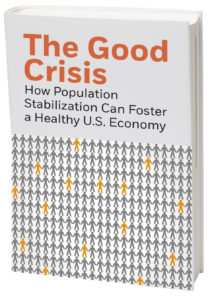
Lower U.S. Fertility Presents an Opportunity for Advancing Equality
The recent slowdown in the U.S. birth rate has resulted in much hand-wringing about our nation’s future (e.g. here, here, and here). Instead of yielding to these dark prognostications, let’s take advantage of this situation, which could be more optimistically viewed as an opportunity. There are some clear advantages to the decline in U.S. births—which is occurring in all age groups of women 15–44 but is most pronounced among teens. And the challenges that slower population growth may pose can be successfully addressed by disrupting the status quo when it comes to our investment in future generations of workers and tax-payers.
Indeed, if the question is where the productive workforce needed for our nation’s future will come from, let’s focus on lifting up the millions of children here in the U.S. who live in poverty—children who disproportionately represent communities of color.
President Biden took a major step in this direction by promoting and signing the $1.9 billion coronavirus relief legislation, which included a dramatic increase in child tax credits. This removed barriers that often block kids from having the kind of lives we all want for our children. Unfortunately, Congress let the relief package expire, without renewing it.
Here in the U.S., one in ten of us live in poverty. Expansion of child tax credits could prove a great benefit for society by dramatically reducing the poverty rate. When you live in a state of constant worry about accessing quality health care, avoiding eviction, hunger, or food insecurity, when you can’t pay the bills, or barely earn enough money to get by even with two jobs, it’s hard to see the future clearly and make confident decisions about anything.
Consider the more than 10 million U.S. children who are trapped in poverty—71% of them children of color. Often, they suffer from poor health due to lack of adequate nutrition and medical care. Even before they begin school, too many lag behind other students in terms of developmental and intellectual milestones. Their parents are often so stressed out from working long hours that they can’t give their children needed care and attention. As teenagers, kids who grow up in poverty drop out of school at a higher rate than those in middle- or high-income households. This is a formula for generational social inequality at every level, especially when more financially fortunate adolescents are playing sports and preparing for college.
Even setting aside the deep personal toll here, this represents an extraordinary waste of potential for a society that needs sophisticated, productive workers to compete in the Information Age.
The legislation signed by President Biden will slash the poverty rate for children in the United States by about 50%. This will mean healthier children. It will mean they’ll advance farther in school. And it will also mean the next generation will be far better equipped to succeed in tomorrow’s complex society where America needs more highly skilled workers.
John Seager, President and CEO of Population Connection, has been interviewed by radio stations around the country this summer on the topic of lower fertility and slower population growth in the United States. The complete list of his interviews is below (with more interviews happening all the time), along with clips where available—click the buttons to hear the audio. If you’re interested in interviewing John, please email us at info@popconnect.org!
12/8/21: “The John Williams Show,” WGN-AM, Chicago, IL
11/30/21: Dan McCargar, KTOE-AM, KTOE-FM, Mankato, MN
11/22/21: “The Tom Sumner Program,” WFOV-FM, Flint, MI
11/9/21: Sean Sweeney, WPKZ-FM, WPKZ-AM, Fitchburg, MA, Boston, MA, Central Massachusetts, Regional
11/1/21: David Lile, “A Columbia Morning,” KFRU-AM/KFRU-FM, Columbia, MO
10/19/21: Mike Crute, “The Devil’s Advocates Radio,” 92.7FM/1580 AM, Madison, WI, Eureka, CA, Chicago, IL, Minneapolis, MN
10/18/21: Russ Heltman, “Healthscope,” WMKV-FM, Cincinnati, OH
10/5/21: Patti Vasquez, Chicago, IL, WCPT-AM
9/27/21: Jim Beach, National School for Start-Ups Radio
9/21/21: Brett Johnson, The Progressive Voice of Minnesota, Minneapolis, MN, AM950
9/20/21: Mary Jane Popp, Sacramento, CA, KAHI-AM/KAHI-FM
9/13/21: WPHM-AM, Paul Miller, Port Huron, MI, and Detroit, MI
9/2/21: KTRC-AM/KTRC-FM, “The Richard Eeds Show,” Santa Fe, NM
8/20/21: (NPR) “The Measure of Everyday Life” with Dr. Brain Southwell, Raleigh/Durham, NC
8/12/21: (NPR) “The WGVU Morning Show” with Shelly Irwin, Grand Rapids, MI
8/10/21: WGTD-FM with Greg Berg, (Wisconsin Public Radio affiliate), Kenosha/Racine, WI
8/9/21: KGO-AM with Mark Thompson, San Francisco, CA (Interview starts at minute 19!)
8/9/21: Delmarva Public Radio with Don Rush, Salisbury/Eastern Shore, MD, Maryland Regional
7/19/21: “The Laura Coates Show,” SiriusXM Radio, P.O.T.U.S. Channel 124
7/9/21: John Liddle, NewsRadio 1080 KRLD, Dallas/Fort Worth, TX
7/8/21: Tony Marino, News 96.5 WDBO, Orlando, FL
6/30/21: Roy Burnette, WRGC, Sylva, NC, and WBHN, Bryson City, NC
6/30/21: Bob Gourley, “Issues Today,” nationally syndicated to 80 + radio stations
We’ve also been pitching opinion pieces to newspapers around the country. Here’s a list of the ones that have been published so far:
John Seager, “Modern contraception is the answer to the overpopulation problem,” The Washington Post, December 2, 2021
Marianne Gabel and John Seager, “Smaller families could be a ‘breath of fresh air’ the world needs,” The Columbus Dispatch, November 16, 2021
JoAnn Sivley Ruppert (Population Connection President’s Circle member), “Smaller families can benefit N.M. and the world,” Santa Fe New Mexican, October 16, 2021
Elaine Gorman and John Seager, “Smaller families could help Modesto and California cope with crises,” The Modesto Bee, Modesto, CA, August 27, 2021
John Seager, “How smaller families can benefit our country,” The Morning Call, Allentown, PA, July 26, 2021
Marian Starkey, “Let’s fully fund international family planning on World Population Day,” The Hill, Washington, DC, July 11, 2021
Marian Starkey, “Let’s Celebrate a Lower Birthrate, Not Lament It,” The New York Times, June 5, 2021
The Good Crisis: How Population Stabilization Can Foster a Healthy U.S. Economy (Population Connection, 2016)
In many developed countries—Japan, South Korea, Italy, Spain, Germany, Canada, and the United States among them—fertility rates are below replacement rate. It’s far from cause for alarm despite claims by “birth dearthers” that we face social and economic catastrophe due to lower birth rates. With global population still growing annually at a rate of nearly 1%, the world continues to add some 70 million people a year.
Offering insights and guidance from prominent academics and journalists, The Good Crisis: How Population Stabilization Can Foster a Healthy U.S. Economy takes on one of today’s most pressing challenges: keeping our aging population healthy, productive, and prepared for today’s technologically-focused jobs. At the same time, today’s youth must be prepared for productive futures through education, skills training, and delayed parenthood.
Dispelling anxieties about the impact of slowing population growth on Social Security, commerce, and society, this collection of essays presents innovative and practical solutions to issues from labor shortages to fossil fuel dependence. Backed by extensive research and real-world examples, The Good Crisis presents a path to a more productive, sustainable world.


